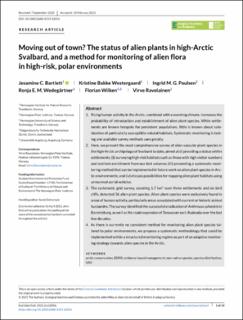| dc.contributor.author | Bartlett, Jesamine | |
| dc.contributor.author | Westergaard, Kristine Bakke | |
| dc.contributor.author | Paulsen, Ingrid M. G. | |
| dc.contributor.author | Wedegärtner, Ronja Elisabeth Magdalene | |
| dc.contributor.author | Wilken, Florian | |
| dc.contributor.author | Ravolainen, Virve | |
| dc.date.accessioned | 2022-03-08T09:27:42Z | |
| dc.date.available | 2022-03-08T09:27:42Z | |
| dc.date.created | 2021-05-10T13:43:28Z | |
| dc.date.issued | 2021 | |
| dc.identifier.citation | Ecological Solutions and Evidence. 2021, 2021 (2), . | en_US |
| dc.identifier.issn | 2688-8319 | |
| dc.identifier.uri | https://hdl.handle.net/11250/2983679 | |
| dc.description.abstract | 1. Rising human activity in the Arctic, combined with a warming climate, mincreases the probability of introduction and establishment of alien plant species. While settlements are known hotspots for persistent populations, little is known about colonization of particularly susceptible natural habitats. Systematic monitoring is lacking and available survey methods vary greatly. 2. Here,we present the most comprehensive survey of alien vascular plant species in the high-Arcticarchipelago of Svalbard to date, aimedat(i) providing a status within settlements;(ii) surveying highrisk habitats such as those with high visitor numbers and nutrient enrichment from seabirdcolonies;(iii) presenting a systematic monitoring method that can be implemented in future work on alien plant species in Arctic environments; and(iv) discuss possibilities for mapping alien plant habitats using unmanned aerial vehicles. 3. The systematic grid survey, covering 1.7 km2 over three settlements and six birdcliffs, detected 36 alien plant species. Alien plant species were exclusively found in are as of human activity, particularly areas associated with current or historic animal husbandry. The survey identified the successful eradication of Anthriscus sylvestris in Barentsburg, as well as therapid expansion of Taraxa cumsect. Ruderalia over the last few decades. 4. As there is currently no consistent method for monitoring alien plant species tailored to polar environments, we propose a systematic methodology that could be implemented within a structured monitoring regime as part of an adaptive monitoring strategy towards alien species in the Arctic. arctic conservation, EDRR, evidence-based management, non-natives pecies, species distribution, UAV | en_US |
| dc.language.iso | eng | en_US |
| dc.publisher | Wiley | en_US |
| dc.relation.uri | https://besjournals.onlinelibrary.wiley.com/doi/full/10.1002/2688-8319.12056 | |
| dc.rights | Navngivelse 4.0 Internasjonal | * |
| dc.rights.uri | http://creativecommons.org/licenses/by/4.0/deed.no | * |
| dc.title | Moving out of town? The status of alien plants in high‐Arctic Svalbard, and a method for monitoring of alien flora in high‐risk, polar environments | en_US |
| dc.type | Peer reviewed | en_US |
| dc.type | Journal article | en_US |
| dc.description.version | publishedVersion | en_US |
| dc.subject.nsi | VDP::Zoologiske og botaniske fag: 480 | en_US |
| dc.subject.nsi | VDP::Zoology and botany: 480 | en_US |
| dc.source.pagenumber | 14 | en_US |
| dc.source.volume | 2021 | en_US |
| dc.source.journal | Ecological Solutions and Evidence | en_US |
| dc.source.issue | 2 | en_US |
| dc.identifier.doi | 10.1002/2688-8319.12056 | |
| dc.identifier.cristin | 1909188 | |
| dc.relation.project | Andre: Norwegian PolarI nstitute | en_US |
| dc.relation.project | Andre: The Governor of Svalbard | en_US |
| dc.relation.project | Andre: Ministry of Climate and Environment | en_US |
| dc.relation.project | Svalbards miljøvernfond: 17/50 | en_US |
| cristin.ispublished | true | |
| cristin.fulltext | preprint | |
| cristin.fulltext | original | |
| cristin.qualitycode | 1 | |

